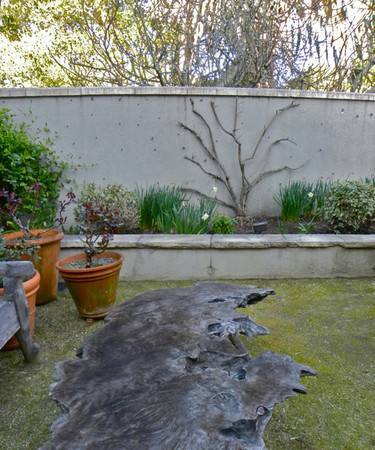
Gross integrates landscape design and art.
Jan is one of the artists with space in Isabel Cooke. Her main media is the landscape; she owns Heritage Landscapes, a San Anselmo design, build and maintain firm. To keep inspired and fresh she works with pastels, acrylics and collage in her studio. She has been a member of Art on the Farm, painting plein air on Marin organic farms. Her work is featured in “Spirit of Color” and “ Spirit of Drawing” by Connie Smith Siege.
Did your urge to draw and paint begin early in your life and how do you incorporate into your landscape design projects?
Jan: I won a scholarship to an art school for the summer in high school and the feedback from the teachers was that I was too messy to be an artist. So, in college I studied honors physics, because I also loved science. I continued to always paint and draw. While traveling around the world, I journaled and painted and when in Afghanistan I ran out of money and traded sketches for food.
When returning from guiding students abroad, my husband needed to finish his PhD and I wanted to be outside, so we got a house in Berkeley and land in Mendocino. I built a platform and put up a tent and found a job weeding for an inn. I then built a huge kitchen garden and people wanted me to do it for them; so that is how it started, a real old-fashioned way with cuttings, seedlings, and kelp and horse manure.
When we moved to Woodacre in 1977, I put out an ad: "Have truck will garden.” And that is how it started – Heritage Landscapes.
My daughter and son worked here in the summers and, after going off to college and into the world, they are both back here working in the company. I get to see my kids every day.
Part of Jan’s process is really playing with color and experimenting with color, looking at color. She has always been intrigued by the interactions of color since childhood.
In her studio she has a big basket of colored paper. Part of her process is to go into her studio with a question and go into the basket of color and pull out the colors that are really pulling her in that particular moment and make a collage with them. That is basically her recipe for her paintings.
Do you use this recipe when designing for your clients?
Jan: In a way, yes. Each person has a unique kind of color core, colors that they are really drawn to and I can see them by what they wear and what makes them really comfortable and turned on. And I like to incorporate that into their landscape to make it really flow from the inside to the outside. I do this by showing them pictures and talking. Each person also relates on an elemental level as well: earth, air, and fire. I need to balance these elements and some people need more of one than the other.
Then there is the actual lay of the land.
Some clients really have to have balance, like an Italian classic garden with boxwood hedges and two cypress trees, very organized. Others, like me; a Japanese garden style is more interesting, where things are slightly off-balance, more intriguing. I like creating pathways where you don’t see the end of them, so you are pulled into the garden. I like to create sitting areas in the garden. I want people in their garden. So, finding ways people can enjoy being in it is important. Looking from inside the house, I want them to say, “Oh, I want to go out there and sit on that bench.” I know when people come outside there is a real healing process that takes place.
Jan says she can tell when a garden is finished by getting the butterflies, birds and insects; a whole other realm of creatures that will come in and enjoy the garden.
Jan is working on a new exciting project. It is a two-acre park in the middle of Meadowcreek Homeowners Association. Her plan was to reuse as much as possible – everything on site. She is sheet composting the chips of 22 trees that were removed as they were diseased. Then her team has graded for a number of rain water gardens/swales to slow and spread the water that comes down from the berms. These rain water gardens are to be planted with no mow grass to reduce the need for water and labor.
Jan: There is a direct connection between the drainage from the park to the Corte Madera Creek, so our intention is to use compost teas for fertilizing so that no chemical fertilizers or herbicides go to the bay. I am on the citizens advisory board for MCSTOPPP (Marin County Stormwater Pollution Prevention Program) and working with many groups on stormwater programs.
Jan's Tuscan project will be part of MCSTOPPP's Marin Eco-Friendly Gardens Tour on May 15 from 10 am to 4 pm. It is sponsored by Marin County Stormwater Pollution Prevention Program, Marin Municipal Water District and North Marin Water District.
See more of the projects she has designed on her website: http://www.heritagelandscapes.net/about.html
Do you have an artistic garden? Tell us in the comments.
Article Courtesy of: http://sananselmofairfax.patch.com

